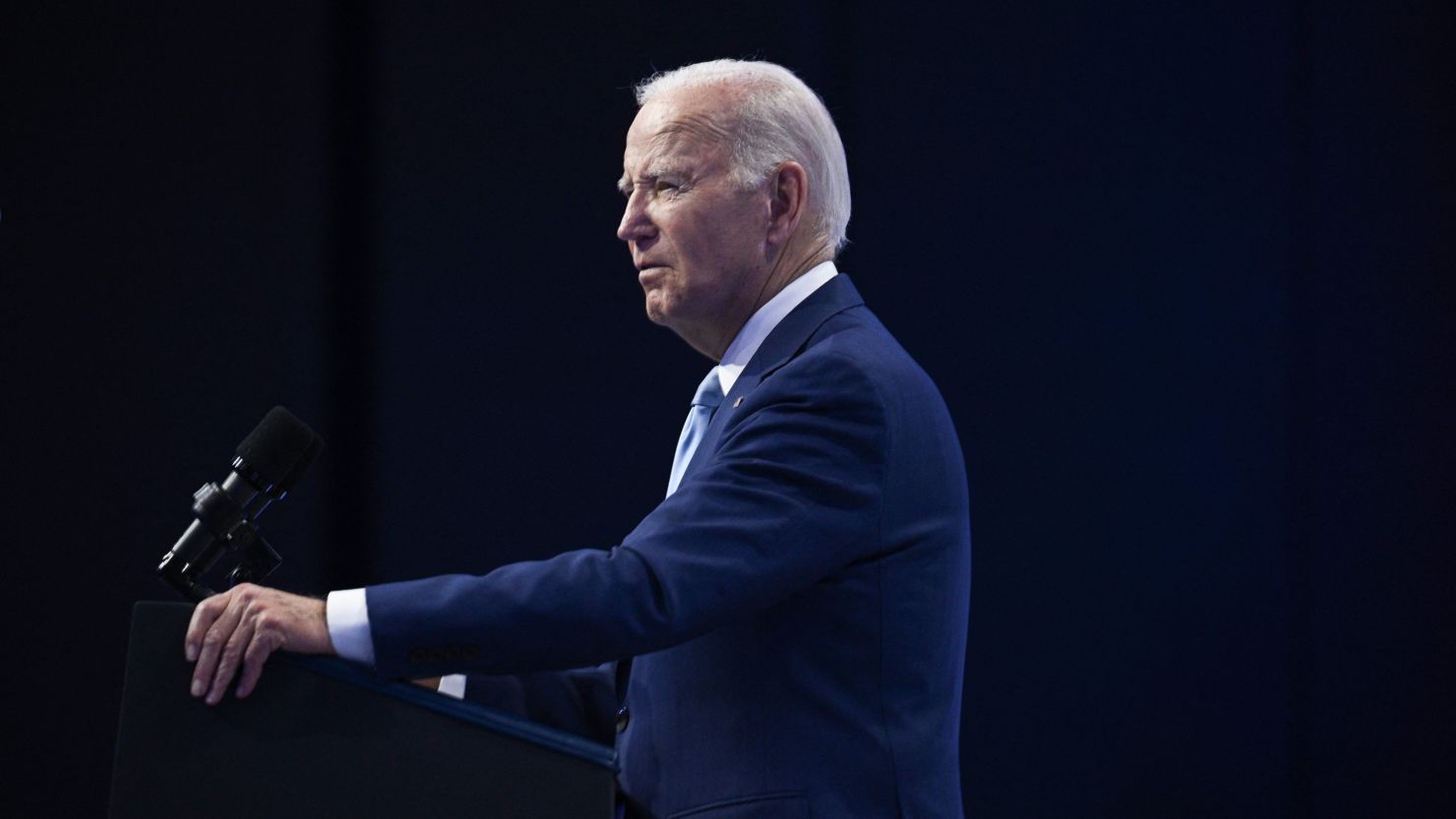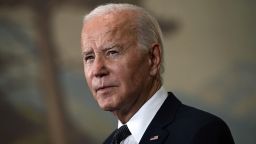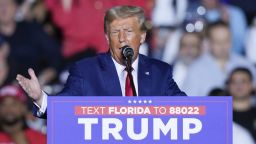President Joe Biden’s weakness in polls among non-White voters is boosting Republican hopes that the GOP is poised to extend its most important political breakthrough of modern times – and potentially to reshape the competition between the two parties along the way.
The most consequential political gain for Republicans in recent decades has been their increasing strength among working-class White voters – a process that began under Presidents Richard Nixon and Ronald Reagan in the 1970s and 1980s but peaked in recent years under Donald Trump. Once the brawny backbone of the Democrats’ “New Deal” coalition that dominated American politics from the 1930s until the 1960s, White voters without a college degree have become the foundation of the modern GOP.
Now some political observers believe working-class minority voters are moving along the same track – and largely for the same reasons. Just as millions of working-class White voters recoiled from Democratic cultural liberalism during the social upheavals of the 1960s and 1970s, they argue, working-class Latino and even Black voters are shifting toward the GOP now in rejection of “woke” ideology on issues such as crime, immigration and LGBTQ rights.
Such arguments are fueling the increasingly common assertions that Republicans are building a “multiracial populist coalition,” as GOP pollster Patrick Ruffini argues in his copiously researched recent book, “Party of the People.”
While “the rightward shift” of White- and non-White voters without a college degree toward the GOP in the Trump years “might seem like two discrete, unrelated events …the two groups share a common working-class DNA and their political shifts stem from the same root,” Ruffini writes.
A wide array of recent polls shows Biden with an unusually small lead for a Democrat among both Black and Latino voters in a potential 2024 rematch with Trump. But many analysts say it’s less clear that Democrats are facing a lasting structural realignment among those voters – much less a change rooted in a long-term cultural alienation from the party – rather than immediate dissatisfaction with the economy under Biden.
“I keep looking for it as well, but you are not seeing as much evidence for a culture war driving any kind of change at this moment,” said Carlos Odio, senior vice president for research at Equis Research, a Democratic polling firm that specializes in Latino voters. “What’s driving Trump and the Republicans is the economy. At the end of the day, ‘It’s the economy, stupid’ over and over again.”
If anything, rather than cultural alienation driving working-class non-White voters toward the GOP, continuing resistance in those communities to Republican priorities on many culturally and racially tinged issues may be Democrats’ best hope in 2024 of recapturing non-White voters disenchanted with Biden’s performance and the economy. Despite all the discontent over Biden, almost three-fifths of non-White voters without a college degree agreed that the “Republican Party has been taken over by racists,” in a recent national survey by the nonpartisan Public Religion Research Institute, according to previously unpublished results provided to CNN.
The stakes in this struggle are enormous. White voters without a college degree, now the electorate’s most Republican-leaning group, have been steadily shrinking as a share of the total vote at a rate of about 2 to 3 percentage points in each presidential election for decades. To offset that decline, Republicans need to find votes elsewhere. The party is facing resistance among college-educated White voters, many of whom have recoiled from the hard-edged cultural and racial views the party has embraced under Trump. To strategists like Ruffini, the most plausible path for the GOP to remain competitive over time is to grow its vote among non-White voters, especially those without college degrees.
“With the Republicans’ strongest group” of White voters without a college degree “shrinking and their weakest set of groups growing, Republicans will need to increase their support levels across all parts of the multiracial populist coalition just to keep pace with where they are today,” Ruffini writes in his engaging new book.
All data sources about voting behavior agree that the GOP has improved its performance among minority voters without a college degree over the past decade. For many observers perhaps the most surprising result in the 2020 election was Trump’s improvement among those voters after four years in which he frequently appealed to White racial resentments and pursued militant immigration policies, such as separating children from their parents at the border.
The exit polls conducted by Edison Research for a consortium of media organizations including CNN found that Trump’s vote among non-White voters without a college degree increased from just 20% in 2016 to 26% in 2020. Research by Catalist, a Democratic voter targeting firm whose analyses are respected in both parties, found that Trump’s vote among Latino voters without a college degree spiked from 61% in 2016 to 72% in 2020; Trump also enjoyed a modest 3 percentage point gain among Black voters without a college degree over that period, Catalist found.
Exactly why Trump made those gains, though, remains a matter of dispute – with important implications for 2024 and beyond. Advocates of the realignment theory argue that Trump’s gains represented an ideological rejection of Democrats among centrist and right-leaning minority voters, prompted partly by their opposition to the calls to “defund the police” in the racial justice protests that erupted after the murder of George Floyd in 2020. They pointed to evidence in exit polls that a much higher percentage of minority voters who identified as conservative voted for Trump in 2020 than in 2016.
But many others, such as Odio, believe Trump’s 2020 non-White improvement was grounded in the belief that he was more qualified to run the economy. Those in this camp believe the key factor for many working-class minority voters was Trump’s determination to quickly reopen the economy after the onset of the Covid-19 pandemic.
Somewhat to the surprise of both parties, the movement of non-college-educated minority voters toward the GOP stalled in the 2022 midterm election, even though those voters expressed widespread disenchantment with the economy and Biden’s performance. In Catalist’s analysis, Democrats won a slightly higher percentage of Latinos without a college degree in the 2022 House races than they did in the 2020 presidential contest. Most important for Democrats, Senate incumbents Mark Kelly in Arizona and Catherine Cortez Masto in Nevada – probably the two states where Latino voters are most important for the party – also ran slightly better among non-college-educated Latinos than Biden did in their states, according to previously unpublished Catalist results provided to CNN. (The exit polls, differing slightly, showed a small further national gain in 2022 for the GOP among non-White voters without a college degree.)
Odio, though, warns that Democrats can only take so much comfort from their 2022 success among minority voters, particularly those without college degrees. The reason, he says, is that the openness toward Trump and the GOP has been most pronounced among economically marginal Latino voters who are largely disconnected from the political system and much less likely to turn out in a midterm than presidential year election. “So much of the dynamism and volatility in the Latino vote is among less frequent voters,” Odio said. “So in important ways, you almost have to clear 2022 out of your mind.” Some Democratic strategists who focus on Black voters believe the same is true in that community.
The swarm of recent polls showing Biden leading Trump only narrowly with Latino and Black voters has prompted a new wave of concern about the party’s position in minority communities. Especially ominous for Democrats is the large share of both Latino and Black voters in multiple polls who say Biden’s economic policies have not helped them and/or say they trust Trump more than Biden to manage the economy.
Daron Shaw, a Republican pollster and University of Texas political scientist who co-conducted a recent large national survey of Latino voters for Univision, says that those attitudes mean “there is absolutely an opening” for Trump or another GOP nominee to advance further with non-White voters in 2024. Just as many White working-class voters “felt like the financial crisis of ’08-‘09 left them rudderless [and] eroded their position in American society … both on economic grounds and on cultural grounds, there are voters within the Latino community as well, who feel no one is representing them,” Shaw said during a press call about the Univision poll.
The risk to Democrats, Shaw argued, is that some of those working-class Latino voters believe the party is distracted by what he sees as cultural causes, such as LGBTQ rights, and “is not as interested” in their bread-and-butter economic concerns “as they have been” previously.
Sergio Garcia-Rios, a University of Texas political scientist who partnered with Shaw on the Univision poll, said the Latinos supporting Trump are drawn to him mostly on economic grounds. “To those who are voting for Trump, they remember that in 2016-’17-‘18 the economy worked better,” he said. “You and I can disagree with them on whether or not that is true. But that’s what they remember.”
Several grassroots organizers who work in minority communities told me that their experience in 2022 demonstrated that Democrats can win an economic argument even among minority voters who feel squeezed by the cost of living under Biden. Melissa Morales, founder and president of Somos Votantes, a group that mobilizes Latino voters, said Cortez Masto’s victory last year showed that Democrats can survive discontent about the economy if they convince voters they are pursuing policies to help them make ends meet.
The key for Biden, she said, is to show Latinos, “‘Here’s what I am doing to try to make this better. We are creating better jobs, I am working actively to lower prices.’ If Biden can present that to voters, there is still an opening here. The fact that costs are high isn’t the end game – it’s what are you going to do about that that voters are looking for.”
Similarly, Matt Morrison – executive director of Working America, a group that politically organizes working-class voters who are not in unions – said the organization’s experience in 2022 showed that there remains “a critical difference” between White and non-White voters without a college degree.
In the group’s door-to-door or phone canvassing efforts, he said, they’ve typically had far more success moving working-class Black and Latino voters to support Democratic candidates around an economic message than they have at persuading White voters at similar education and income levels. Even when organizers can win an economic argument with working-class White voters, he said, those voters often still remain dubious of Democrats because they believe the party favors minorities. That second barrier doesn’t exist with voters of color, Morrison said. “When you communicate to Black and brown voters, they are far more likely to come back to Democrats,” Morrison said. “They lack that social glue that makes them say, ‘I am of a different tribe.’”
Even so, the depth of discontent about the economy among minority voters is likely to remain a crucial hurdle for Biden. Democrats are accustomed to winning at least 7 in 10 minority voters in presidential elections; even if inflation continues to subside, it seems highly unlikely by Election Day that 7 in 10 minority voters will put more faith in Biden than a Republican to manage the economy.
That means if Biden is to match, or even approach, Democrats’ historic performance among minority voters, he’ll need other issues to convert some who are dubious about his economic record. And resistance to the GOP’s priorities on cultural and racially tinged issues probably offers him the best opportunity.
Those who assert that minorities are abandoning the Democratic Party on cultural grounds often point to the large share of non-White voters who express broad views about US society more often associated with Republicans. Ruy Teixeira, a longtime Democratic electoral analyst who has become an unflinching critic of the party’s policies on social issues, has noted, for instance, that most Latinos agree with statements asserting the US is the greatest country in the world and reject the idea that racism is embedded in American institutions. “It is difficult to avoid the conclusion that Democrats’ emphasis on social and democracy issues, while catnip to some socially liberal, educated voters, leaves many working-class and Hispanic voters cold,” writes Teixeira, co-author of the recent book, “Where Have All The Democrats Gone?,” which makes similar arguments as Ruffini.
Yet as polling by the Public Religion Research Institute, Univision and other groups show, on many of the actual cultural policies dominating political debate, most minority voters – including most of those without a college degree – align with Democrats, not Republicans. Among non-White voters without a college degree, 57% support legal abortion, 55% back same sex-marriage, and 64% oppose placing barriers at the US border to deter migrants, according to unpublished results from the PRRI’s latest national American Values Survey provided to CNN. (Support for Democratic positions is even greater among non-White voters with a college degree, PRRI found.) Other surveys have found preponderant support among minorities for banning assault weapons and lopsided opposition to ending birthright citizenship for the children of undocumented immigrants, as Trump and other GOP candidates have proposed.
Maybe most significantly, in PRRI polling, about three-fifths of non-White voters without a college degree agree the GOP has been “taken over by racists,” as do nearly two-thirds of non-White voters with a degree. By contrast, three-fifths of White voters without a college degree reject that idea.
Analysts like Odio believe one reason Trump improved among Latinos in 2020 was that he downplayed the harsh language about immigration he used in 2016 and instead emphasized his economic agenda. But Trump has again moved sharply to the right on immigration, pledging mass deportations, internment camps for migrants, the end of birthright citizenship, and military action against Mexico to fight drug cartels. He’s also refused to rule out reinstating his policy of separating migrant children from their parents at the border.
Latinos in the key states may not yet be aware of Trump’s immigration plans. But Robert P. Jones, president and founder of PRRI, said the group’s polling convinces him that Trump’s agenda on immigration and other cultural issues will ultimately repel some Latino voters otherwise disenchanted with Biden on the economy. “I think we will not know the truth about how much they [Republicans] are overplaying their hand until next summer” if Trump becomes the GOP nominee, Jones said.
Some expressions of cultural liberalism – such as the fleeting calls in 2020 to “defund the police” – have clearly rankled working-class minority voters. But Biden never endorsed that idea. And his clearest path to recovering with those voters may be to convince them that the Republican agenda on immigration and other cultural issues threatens their interests and values. Rather than driving further movement toward the GOP among minority voters, in other words, issues such as abortion or immigration may be Biden’s best hope of preventing slippage with those voters.
Odio says that in Equis’ polling, the parties are in mirror-image positions with the Latino community. “Among Latinos, Democrats are seen as caring, but there are doubts about their ability to deliver,” he said. “The thought is Republicans might be better at delivering, but there’s an underlying fear they don’t care.”
Which side of that equation proves more compelling not only to Latino, but also to Black and other minority working-class voters, will go a long way toward determining whether Biden can win a second term.






